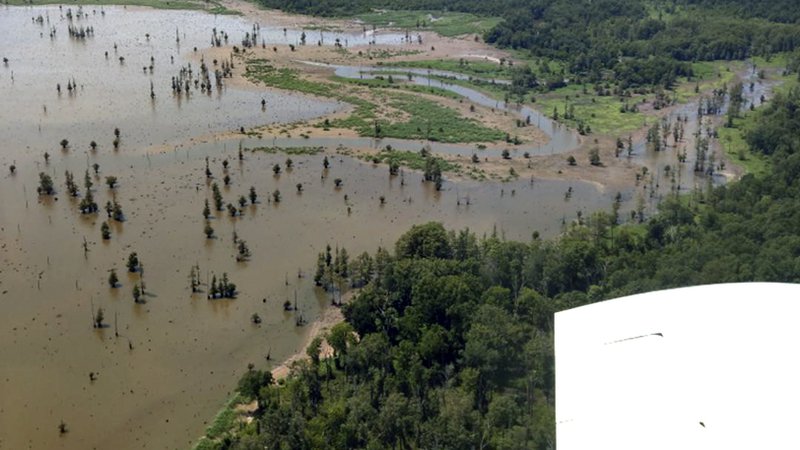AGFC air drops waterfowl habitat on Millwood Lake
ON 07-25-2018

July 25, 2018
Randy Zellers
Assistant Chief of Communications
SARATOGA – Arkansas Game and Fish Commission biologists increased the food available to wintering waterfowl on Millwood Lake last Friday with a special air delivery of Japanese millet around 500 acres along the edge of the lake.
Each year the AGFC works with the Southwest Arkansas Water District and the Little Rock District of the U.S. Army Corps of Engineers to enhance aquatic and terrestrial habitat on Millwood and increase water quality in the lake. The lake is drawn down 2 feet in summer, which dries and compacts much of the sediment in the shallow portion of the lakebed.
“Millwood is a large, shallow bowl, so dropping the water level by 2 feet exposes a lot of mudflats,” said Griffin Park, biologist supervisor at the AGFC’s Hope Regional Office. “The vegetation that springs up on those mudflats can be manipulated through further water level changes to create excellent wildlife habitat.”
Annual smartweeds and native millets will begin to sprout on the mudflats from seeds remaining from previous years, but biologists hedge their bets by aerially seeding mudflats on the western end of the main lake while the soil is still wet.
“We loaded and aerially dropped 7,500 pounds of Japanese millet over roughly 500 acres of mudflats last Friday to offer even more food for wintering waterfowl,” Park said. “The water level dropped a little faster than anticipated, so we had to get everything organized and planted quickly.
“It took three-and-a-half trips for the plane we contracted, but we were able to seed that 500 acres in two hours,” Park said. “With the right water level fluctuations, that can produce some excellent duck food by the time waterfowl makes it to Millwood.”
Park says the water level will be held 2 feet low until late August to allow the millet to begin to grow, then the Corps will close the gates to let the water level slowly rise and encourage growth of the smartweeds and millet.
Bass, crappie and other sportfish on Millwood also will benefit from the project. The lowered water level allows the lakebed to dry and compact, which prevents siltation and promotes the hard bottom many species need for spawning. The drawdown also concentrates prey fish and predators together, increasing growth in popular sport fish species.
“This is one of those projects that benefits many species beyond its initial target,” Park said. “And it’s thanks to our partners at the Corps and Southwest Arkansas Water.”
Eastern Arkansas may garner most of the duck-hunting world’s attention, but excellent duck hunting can be had throughout the state, and the Red River Valley in Southwest Arkansas is no exception.
“Millwood Lake provides a lot of hunting opportunity in this part of the state,” Park said. “We get a lot of blue-winged teal in September and we have an excellent opportunity for early Canada geese on Millwood, with a lot of banded birds from resident populations. During the regular duck season, you’ll see mallards, gadwalls and green-winged teal. Millwood’s open water also attracts canvasbacks, redheads, scaup and other diving ducks. It isn’t the same kind of hunting you’ll find at Bayou Meto or Black River WMAs, but many hunters can take advantage of the duck hunting here without driving across the state.”
Recent News

AGFC Commissioner Meeting Notice
Jul. 15, 2025

Arkansas Wildlife Weekly Fishing Report
Jul. 10, 2025
Subscribe to Our Weekly Newsletter E-mails
Don’t miss another issue. Sign up now to receive the AGFC Wildlife Weekly Newsletter in your mailbox every Wednesday afternoon (Waterfowl Reports are published weekly during waterfowl season and periodically outside the season). Fishing Reports arrive on Thursdays. Fill in the following fields and hit submit. Thanks, and welcome!
